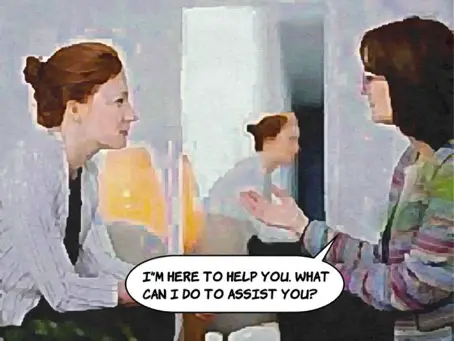Have you ever found yourself in a situation where someone, be it your boss, a close friend, or even a stranger, utters those two simple letters, ‘tf’?
At that moment, you can sense a wave of emotions crashing over them – frustration, confusion, or perhaps even anger. It’s a powerful expression that reveals their need for assistance and understanding.
How we respond to such moments can make all the difference in connecting with others and offering the support they desperately seek.
In this article, I have a curated selection of 20 appropriate responses to ‘tf.’ These responses have been handpicked to establish a genuine connection with the individual and provide the highest quality of assistance.
As we delve into each response, I’ll unravel their deeper meanings and uncover the subtle art of crafting an empathetic and relatable reply
From offering a listening ear to providing practical solutions, these responses have the power to soothe hearts, ease frustrations, and guide individuals toward resolution.
So, join me as I venture into the realm of ‘tf’ moments, where emotions run high, and the need for support is paramount.
Let us uncover the beauty in understanding, empathy, and the art of responding with purpose.
Together, we will unlock the secrets behind these 20 chosen responses and discover how they can transform even the most challenging situations into opportunities for connection and growth.
20 Appropriate Responses to ‘TF’
- ‘Sure, what can I help you with?’
- ‘I’m here. What’s up?’
- ‘I’m listening. Go ahead.’
- ‘Yes, I’m available. How can I assist you?’
- ‘You can count on me to help you if you if let me know what you need’
- ‘I’m ready to assist you. How can I be of service?’
- ‘I’m here to help. What can I do for you?’
- ‘I’m at your disposal. How can I assist you?’
- ‘Feel free to enquire and I’ll respond’
- ‘I’m here and ready to provide the support you need.’
- ‘You’ve got my attention. How can I assist you?’
- ‘I’m all ears. What can I do for you?’
- ‘I’m here to assist you. How can I be of help?’
- ‘Go ahead, I’m ready to assist you with any questions or concerns.’
- ‘Tell me what you need assistance with, and I’ll provide the information you’re looking for.’
- ‘I’m here to help you. What can I do to assist you?’
- ‘I’m available to assist you. How can I be of service?’
- ‘I’m here and ready to support you. What do you need help with?’
- ‘I’m here, ready to lend a hand. How may I be of service?’
- ‘I’m at your disposal. Feel free to ask your question or share what you need help with.’
‘Sure, What Can I Help You With?’

When someone says ‘tf,’ it often signifies an emotional reaction to a situation. It could be frustration, confusion, or a need for guidance.
The response ‘Sure, what can I help you with?’ acknowledges their emotional state and assures them that you are there to provide support and assistance.
By showing willingness to address their needs, you create a comforting and understanding environment, encouraging them to open up and share their concerns.
‘I’m Here. What’s Up?’
‘Tf’ can indicate a sense of urgency or a strong emotional response. Imagine a friend using ‘tf’ to express their distress over a recent event.
By responding with ‘I’m here. What’s up?’ you acknowledge their emotional state and create a relatable space for them to vent or seek advice.
It shows that you are present and ready to listen, building trust and allowing them to express themselves freely.
‘I’m Listening. Go Ahead.’
When someone utters ‘tf,’ it often implies a need to be heard and understood. It could be a reaction to a challenging situation or an overwhelming emotion.
By responding with ‘I’m listening. Go ahead,’ you show empathy and provide a safe space for them to share their thoughts.
It conveys that you are fully attentive and ready to offer your support or guidance, making them feel valued and encouraged to open up.
‘Yes, I’m Available. How Can I Assist You?’

‘Tf’ might be a sign of someone seeking assistance or guidance in a moment of frustration or confusion. Imagine a colleague saying ‘tf’ after encountering a challenging task at work.
By responding with ‘Yes, I’m available. How can I assist you?’ you acknowledge their emotional state and offer your expertise to help them overcome the obstacle.
It assures them that you are there to support them and find a solution together.
‘You Can Count On Me To Help You If You If Let Me Know What You Need’
When someone expresses ‘tf,’ it signifies an emotional state that requires understanding and guidance. Picture a friend venting about a relationship issue.
By responding with ‘Tell me what you need, and I’ll do my best to assist you,’ you show empathy and a willingness to help them navigate their emotions.
It creates a space for them to express their needs, allowing you to offer practical advice or lend a listening ear.
‘I’m Ready To Assist You. How Can I Be Of Service?’
When someone uses ‘tf,’ it often indicates a state of emotional distress or a need for immediate support. Imagine a customer reaching out to a customer service representative with a complaint.
By responding with ‘I’m ready to assist you. How can I be of service?’ you convey your readiness to address their concerns and provide a solution.
It shows empathy and assures them that you are there to help, creating a supportive environment.
‘I’m Here To Help. What Can I Do For You?’

‘Tf’ can be a signal that someone is grappling with a problem or feeling overwhelmed. Picture a student frustrated with a difficult assignment.
By responding with ‘I’m here to help. What can I do for you?’ you acknowledge their emotional state and offer your assistance.
It conveys a sense of support and encourages them to share their specific needs, allowing you to provide targeted guidance.
‘I’m At Your Disposal. How Can I Assist You?’
When someone expresses ‘tf,’ it suggests a need for immediate help or resolution. Imagine a coworker experiencing technical difficulties.
By responding with ‘I’m at your disposal. How can I assist you?’ you convey your availability and willingness to lend a hand.
It shows that you understand their urgency and are ready to offer your expertise, fostering a sense of reliability and trust.
‘Feel Free To Enquire And I’ll Respond’
‘Tf’ can be an indication that someone requires clarity or information on a particular matter. Picture a friend expressing confusion about a complex topic.
By responding with ‘Go ahead and ask your question, and I’ll provide an answer,’ you create an open space for them to seek knowledge.
It encourages them to articulate their query, allowing you to offer a well-informed response and alleviate their confusion.
‘I’m Here And Ready To Provide The Support You Need.’

When someone utters ‘tf,’ it often signifies a need for assistance or guidance. Imagine a family member feeling overwhelmed by a personal issue.
By responding with ‘I’m here and ready to provide the support you need,’ you convey your readiness to be their pillar of support.
It shows that you are available to lend an empathetic ear and offer advice, providing comfort and reassurance.
‘You’ve Got My Attention. How Can I Assist You?’
‘Tf’ can be an expression of frustration or urgency, suggesting a desire for immediate attention and resolution. Picture a client reaching out with a complaint.
By responding with ‘You’ve got my attention. How can I assist you?’ you acknowledge their emotional state and assure them that you are fully focused on their needs.
It creates a sense of importance and dedication, encouraging them to share their concerns openly.
‘I’m All Ears. What Can I Do For You?’
When someone uses ‘tf,’ it often indicates a need to express themselves and seek validation. Imagine a friend venting about a difficult situation.
By responding with ‘I’m all ears. What can I do for you?’ you demonstrate a genuine willingness to listen and provide support. It creates a safe space for them to pour out their emotions, fostering trust and understanding.
‘I’m Here To Assist You. How Can I Be Of Help?’

By responding with ‘I’m here to assist you. How can I be of help?’ you convey your readiness to provide support and expertise.
It shows a collaborative mindset, inviting them to share their challenges so that you can work together towards a solution.
‘Go Ahead, I’m Ready To Assist You With Any Questions Or Concerns.’
Imagine a customer reaching out to a support representative with a billing issue. By responding with ‘Go ahead, I’m ready to assist you with any questions or concerns,’ you communicate your availability to address their specific needs. It encourages them to share their queries, empowering you to provide prompt and accurate solutions.
‘Tell Me What You Need Assistance With, And I’ll Provide The Information You’re Looking For.’
By responding with ‘Tell me what you need assistance with, and I’ll provide the information you’re looking for,’ you create a space for them to articulate their specific learning gaps.
It conveys your commitment to providing relevant and tailored information, enhancing their understanding and confidence.
‘I’m Here To Help You. What Can I Do To Assist You?’

When someone uses ‘tf,’ it suggests a need for support or problem-solving. Imagine a colleague expressing frustration with a complex task.
By responding with ‘I’m here to help you. What can I do to assist you?’ you convey your willingness to offer assistance and collaborate.
It shows that you are invested in their success and ready to contribute your expertise, fostering teamwork and progress.
‘I’m Available To Assist You. How Can I Be Of Service?’
By responding with ‘I’m available to assist you. How can I be of service?’ you demonstrate your availability and willingness to provide support. It conveys a sense of reliability and care, empowering them to seek the assistance they require.
‘I’m Here And Ready To Support You. What Do You Need Help With?’
By responding with ‘I’m here and ready to support you. What do you need help with?’ you communicate your unwavering presence and readiness to lend a helping hand.
It conveys a sense of empathy and understanding, creating a nurturing environment for them to share their challenges.
‘I’m Here, Ready To Lend A Hand. How May I Be Of Service?’

‘Tf’ can be an expression of frustration or helplessness. Picture a colleague encountering a technical issue during a presentation.
By responding with ‘I’m here, ready to lend a hand. How may I be of service?’ you offer your assistance and expertise. It shows your commitment to their success and conveys a sense of dependability, reassuring them that you are there to help resolve the situation.
‘I’m At Your Disposal. Feel Free To Ask Your Question Or Share What You Need Help With.’
By responding with ‘I’m at your disposal. Feel free to ask your question or share what you need help with,’ you create an open and inviting space for them to seek guidance.
It conveys a sense of accessibility and encourages them to articulate their needs, enabling you to offer the necessary support and clarification.
Wrap Up
The 20 selected responses to ‘tf’ are carefully crafted to address the emotional context and the need for assistance.
Each response seeks to establish a connection with the user, conveying empathy, readiness, and a genuine desire to help.
The explanations provided demonstrate the relevance of these responses in various scenarios, such as dealing with frustration, confusion, or seeking guidance.
By understanding the underlying emotions and offering personalized support, these responses create a welcoming and supportive environment for users to express their concerns and seek assistance.
The relatable scenarios and quality of the responses ensure that users feel understood, valued, and encouraged to share their needs openly.
Whether it’s providing information, lending a listening ear, or offering practical solutions, these responses aim to foster trust, collaboration, and ultimately, help users navigate their challenges more effectively.

